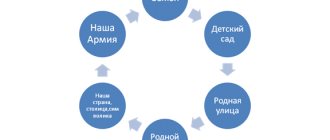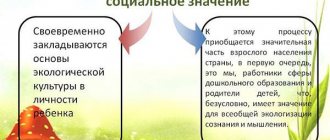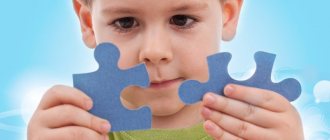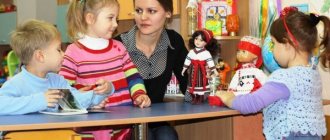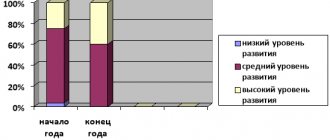Pedagogical advice: Environmental education in kindergarten
Pedagogical Council "Environmental education in kindergarten."
Goal : to improve work in kindergarten to form the foundations of environmental culture in preschoolers. Progress of the teaching council: The amazing world of nature greets the child with a sea of sounds and smells, riddles and secrets, makes him stop, listen, look closely, and think. A field, a meadow, a quiet river, a tiny puddle have their secrets. But wherever the kindergarten is located: in a noisy city or in a quiet village, beyond the Arctic Circle or in the steppe, a teacher who loves nature helps children take their first steps into an unknown country called nature. I invite you to talk about environmental education of children, share your experiences and ideas to improve the efficiency of the educational process. What does the term "Ecology" mean? The word “ecology” itself is derived from the Greek “ekos” - “house” and “logos” - the science of the interactions of living organisms and their communities with each other and with the environment. The term was first proposed by German biologist Ernst Haeckel in 1866. Some possible definitions of the science of “ecology”: • Ecology is the knowledge of the economy of nature, the simultaneous study of all the relationships of living things with organic and inorganic components of the environment... In a word, ecology is a science that studies all the complex relationships in nature. • Ecology is the science of the environment and the processes occurring in it. What is meant by environmental education of preschool children? Environmental education of preschool children involves: – fostering a humane attitude towards nature (moral education); – formation of a system of environmental knowledge and ideas (intellectual development); – development of aesthetic feelings (the ability to see and feel the beauty of nature, admire it, the desire to preserve it); – participation of children in activities feasible for them to care for plants and animals, to preserve and protect nature; – environmental education is a system aimed at the formation of the principles of environmental culture and the development of environmental culture in children and adults; – the system of environmental education is the creation of conditions, certain content, methods and forms of work with children and parents. Why, in your opinion, does environmental education need to start from preschool age? Preschool age is the most favorable period of environmental education. It is at this age that vivid, imaginative emotional impressions, the first natural history ideas accumulate, and the foundation of a correct attitude towards the world around us and a value orientation in it is laid. Love for nature, a conscious, careful and interested attitude towards it in every person should be cultivated from early childhood in the family and kindergarten. What is the role of the teacher in the environmental education of a preschooler? Environmental education of preschoolers should be carried out by a teacher who himself has knowledge in the field of ecology, who loves nature and cares about it. It presents a complex of environmental knowledge in an accessible, exciting form based on the principle of developmental education and aimed at developing the child’s personality. Takes into account interest and age characteristics. In what types of children's activities is it possible to consolidate environmental knowledge? In the process of environmental education, the following types of activities can take place: – role-playing game, reflecting various events in nature or the activities of adults; – practical activities to create or maintain conditions for living objects in the green area of the kindergarten (work in nature), as well as activities to restore objects (repairing toys, books); – children's creativity based on impressions of nature or the activities of people in nature; – communication with nature, contact with objects of flora and fauna; – experimentation: practical cognitive activity with natural objects; – speech activity (questions, messages, participation in conversation, dialogue); exchange of information, impressions, clarification of ideas about nature using words; – observation (independent cognitive activity), providing information about the nature and activities of people in nature; – viewing books, paintings, television programs with natural history content, activities that contribute to obtaining new and clarifying existing ideas about nature; – project activities. In order to develop in children: the need to communicate with representatives of the animal and plant world, cognitive interest in them, the ability to see and understand beauty, the need for self-expression in creative activity, conditions are created in kindergarten where children can, with daily free access, replenish their knowledge, realize the need to communicate with nature. Message from the teacher “Creating an ecological and developmental environment in preschool educational institutions.” Business game Your task is to show knowledge about the life of flora and fauna, the state of the weather, signs according to the folk calendar. 1 part. Warm up. Participants take turns answering the leader’s question. Questions for the first team 1. How is rain formed? (Rain is formed by the condensation of water vapor, which collects in clouds, transforming into clouds, from which drops of water fall onto the surface of the earth. This phenomenon is a consequence and an integral part of the water cycle in nature.) 2. What is fog? (Fog is a form of release of water vapor in the form of microscopic drops or ice crystals, which, collecting in the ground layer of the atmosphere (sometimes up to several hundred meters), make the air less transparent.) 3. Which tree and shrub plants bloom at the same time during spring? and leaf buds? (The maple blooms at the same time as the leaves bloom.) 4. Which trees begin to flow sap the earliest? (At birch and maple). 5. Why don’t cuckoos build nests and hatch chicks? (She picked up this habit a long time ago, because she has evolutionarily adapted to this parasitic method of breeding chicks. Despite its large size, the cuckoo lays small eggs so that small birds do not realize that they have a foundling in their nest. Each species of cuckoo chooses the nest of those birds , whose eggs resemble her own in color, because if they notice the catch, the owners will simply throw away someone else’s egg). 6. Why do bunnies always tremble? (Heat develops in the trembling muscles, which bunny rabbits use to warm themselves.) 7. Which herbaceous plant has pink young flowers and purple flowers in old ones? (At the lungwort). 8. What is a squirrel's nest called? (Gayno. The spherical outside of the nest is disguised with leaves. Spruce branches, the inside is lined with moss, grass, wool, sometimes finely plucked bast. A caring squirrel mother has from three to five nests. When parasites breed in a warm nest, the squirrel transfers the squirrels to another nest. She does the same in a moment of danger.) Questions for the second team 1. How is a rainbow formed? (Rainbows are usually explained by simple refraction and reflection of the sun's rays in raindrops). 2. How can you tell from the snow in a ravine where is south and where is north? (On the southern slope of the ravine, the snow melts faster, so there is less of it there. On the northern slope, the snow melts more slowly, and there is more of it there). 3. Which tree’s leaves never change color and fall green in the fall? (Alder leaves). 4. Which butterflies wake up in the spring and fly out first? (In the spring, the first to fly are urticaria, lemongrass, cabbageweed, and hawthorn). 5. Why do swifts never land on the ground? (On the ground, swifts are helpless - their short legs are adapted only for crawling. A swift is also not able to take off from the ground on its own - its long wings hit the ground when flapping. The absence of a hind finger does not allow it to grasp a branch). 6. Which tree “changes clothes” either gray-silver or green? (Aspen. It’s its leaves that tremble. Aspen leaves tremble even in calm weather, since their petioles in the upper part are strongly flattened.) 7. Which animal is the cleanest? (Badger. Near the hole it is always clean, the badger makes a toilet - deep holes - a few meters from the hole. When the hole is full, the badger buries it and makes a new one. When he goes hunting. He cleans the fur from the earth stuck to it, straightens the hairs crushed in the hole .). 8. Why do nettles “burn”? (The hairs on nettle leaves contain formic acid. When you touch the skin, the tip of the hair breaks, the walls of the hairs containing silica make a wound on the skin, the liquid pours onto the wound and causes a burning sensation.) Part 2. Legends about plants. Plants have played an important role in the life of all peoples since ancient times. There are many different stories associated with them. Each plant has its own history, and a very ancient history has turned into a legend. Teams are offered photographs of plants; participants must determine their name and tell a legend about them. Iris The name of the plant comes from the Greek word iris - “rainbow”. According to ancient Greek mythology, the goddess of the rainbow Iris (Iris) fluttered across the sky on light, transparent, rainbow wings and carried out the orders of the gods. People could see it in raindrops or on a rainbow. A flower was named after the golden-haired Iris, the shades of which were as magnificent and varied as the colors of the rainbow. Viburnum There is such a legend about viburnum. There were once viburnum berries that were sweeter than raspberries. A beautiful girl fell in love with a proud blacksmith, who did not notice her and often wandered through the forest. Nothing helped, and then she decided to burn that forest. The blacksmith came to his favorite place, and everything there burned down. Only one viburnum bush remained, watered with burning tears. And under the bush the blacksmith saw a tear-stained beauty. His heart grew attached to the girl, he fell in love, but it was too late. Along with the forest, the girl’s beauty quickly burned away. And viburnum restored the guy’s ability to respond to love, and in his old age he saw the image of a young beauty in his hunched old woman. But since then, the viburnum berries began to taste bitter, like tears of unrequited love. And there was a belief that a bouquet of viburnum, applied to an aching heart in love, soothes the pain. Lily Ancient Greek myths attributed divine origin to the lily. According to one of them, one day the goddess Hera fed the baby Ares. Drops of splashed milk fell to the ground and turned into snow-white lilies. Since then, these flowers have become the emblem of the goddess Hera. Among the ancient Egyptians, the lily, along with the lotus, was a symbol of fertility. Christians also adopted their love for her, making her a symbol of the Virgin Mary. The straight stem of the lily represents her intelligence; drooping leaves - modesty, delicate aroma - divinity, white color - chastity. According to legend, the lily was held by the Archangel Gabriel when he notified Mary of the imminent birth of Christ. Birch In Russia, birch has been a symbol of grace and purity since ancient times, which personifies Russian nature and Russian woman. One of the legends tells about a beautiful mermaid who lived in a forest lake. At night she came out of the water and frolicked under the moon. However, as soon as the first rays of the sun appeared, the mermaid immediately dived into her cool home. One day she started playing and did not notice how the young sun god Khors appeared in the sky on his solar chariot. He saw the beauty and fell madly in love with her. The mermaid wanted to hide in the lake, but the golden-haired god did not let her go. So she remained standing forever, turning into a beautiful white-trunked birch tree. Part 3. Breaking ring “Weather Bureau” Teams are given envelopes with leaflets. On some the beginning of the sign is written, on others - the continuation. Participants must quickly and correctly collect folk signs. An abundance of snow in January means a rainy summer. Late flowering of rowan - for a long autumn. Abundant dew on the grass means clear, hot weather. The titmouse begins to squeak in the morning - it means frost. Clover folds its leaves to indicate an approaching storm. Lots of berries - for a cold winter. Frogs croak - it means rain. If lightning flashes in early spring, but thunder is not heard, there will be a drought in the summer. Part 4 Solving pedagogical situations. 1. Ira walked home from kindergarten through a park planted with currant bushes and loudly told her mother how the whole group watered them here. But the mother was busy with her own thoughts. - Why are not you listening to me? - Ira asked and pulled out her hand. - What kind of whims is this?! - the mother flared up and, breaking a young currant branch, whipped the girl with it. And then she said angrily: “Who needs your troubles, it’s just a child’s game!” Without you, there will be enough conservationists. What negative consequences could the mother’s action have? 2. In the kindergarten area, the girls play shopping and replenish the assortment of “products” by picking off plants: yellow acacia pods - “beans”, chamomile heads - “sweets”, etc. Irina Petrovna came up and praised: “Well done! Well thought out! »Name the teacher’s mistakes. What would you do in this situation? Summing up the results of the teachers' meeting. Discussion of draft decisions.
We recommend watching:
Analytical report of the preschool educational institution on the organization of work. Section "Environmental Education" Encyclopedia - one of the forms of introducing preschoolers to the natural world of their native land Ecological trail in kindergarten Musical lesson in the senior group on the topic: Winter
Similar articles:
Ecology in music
Plot-based didactic games on ecology in kindergarten for middle group children
Ecological holidays and leisure activities in preschool educational institutions. Scenarios
Teacher's report at the teachers' council on environmental education of preschoolers
Report on the topic: “Visual modeling as a means of introducing preschool children to ecological culture.”
Preschool childhood is the initial stage in the formation of the human personality. During this period, the foundations of personal culture are laid. The main goal of environmental education as a means of developing preschool children is the formation of the principles of ecological culture: the child’s correct attitude towards nature, his surroundings, towards himself and people as part of nature, towards things and materials of natural origin that he uses. This attitude is based on basic knowledge of an environmental nature. Nature is the most important means of education and development of preschool children. How many discoveries a child makes while communicating with her! Every living creature seen by a baby is unique. There are also a variety of natural materials (sand, clay, water, snow, etc.) with which children love to play. Environmental education of preschool children is an introduction to nature for children, which is based on an ecological approach, and the pedagogical process is based on the fundamental ideas and concepts of ecology. The modern, qualitatively new stage in the development of environmental education and training offers a variety of programs that contribute to its effectiveness: “Young Ecologist” - S.N. Nikolaeva: “Our home is nature” - N.A. Ryzhova; “The planet is our home” - I.G. Belavina and N.G. Naydenskaya; “We are opening the world” - T. Klimova and N. Taranova and others. Preschool age is a bright, unique page in the life of every person. It is during this period that the process of socialization begins, the child’s connection with the leading spheres of existence is established: the world of people, nature, the objective world. There is an introduction to culture, to universal human values. Preschool childhood is the time of initial personality formation. Formation of the foundations of self-awareness and individuality of the child. Relevance: The importance of environmental education for preschool children is currently very well substantiated, understood by teachers, and is unlikely to require additional evidence. After all, it is in preschool childhood that the foundations of personality are laid, including a positive attitude towards nature and the world around us. Modeling is an indirect practical or theoretical study of an object, in which it is not the object itself that interests us that is directly studied, but some auxiliary artificial or natural system: • located in some objective correspondence with the cognizable object; • capable of replacing it in certain respects; • during its study, it ultimately provides information about the modeled object itself. Modeling is considered as a joint activity of the teacher and children in constructing, selecting and constructing models. Modeling is based on the principle of replacing real objects with objects depicted schematically or with signs. The peculiarity of modeling as a teaching method is that it makes visible the properties, connections, relationships of objects that are hidden from direct perception, which are essential for understanding facts, phenomena, in the formation of knowledge that is close in content to concepts. The purpose of modeling is to ensure that children successfully master knowledge about the characteristics of natural objects, their structure, connections and relationships that exist between them. Requirements for the model. A model as a visual and practical tool must meet a number of requirements: 1. Clearly reflect the basic properties and relationships that are the object of cognition, and be similar in structure to the object being studied. 2. Be easy to perceive and accessible for creating and acting with it 3. Vividly and clearly convey those properties and relationships that should be mastered with its help 4. It should facilitate cognition Objectives: • Increasing the efficiency of work on environmental education of children, with using modeling. • Formation of initial skills and habits of environmentally literate behavior that is safe for nature and for the child himself. • Formation of the ability and desire to preserve nature and, if necessary, provide assistance to it (care for living objects), as well as skills in basic environmental activities in the immediate environment. Development of cognitive interest in nature, speech, thinking, memory, ability to formulate conclusions Types of models: In didactics, three types of models are distinguished: 1. Subject model; 2. Subject-schematic model; 3. Graphic models. 1. An object model has the form of a physical structure of an object, is similar to the object, reproduces its main parts, design features, proportions and relationships of parts in space. What distinguishes such a model from a toy is the accuracy of its reproduction of essential connections and dependencies within the modeled object or between them, and the ability to detect these dependencies in activities with the model. 2. Subject-schematic model Here, the essential components identified in the object of knowledge and the connections between them are indicated using substitute objects and graphic signs. 3.Graphical models generally convey different types of relationships (graphs, formulas, diagrams). A mnemonic table is a diagram that contains certain information. Mastering the techniques of working with mnemonic tables significantly reduces training time, and at the same time solves problems aimed at developing memory, attention, and imaginative thinking; transformation from abstract symbols to images; development of fine motor skills of the hands with full or partial graphic reproduction. Mnemonic tracks carry educational information, but in a small volume. The development of children’s ability to model and substitute is facilitated by “sketching” riddles. The use of models is an effective way to develop ecological concepts and ideas in preschoolers, since it makes it possible to demonstrate processes that cannot be shown in nature. They are easy to understand, easy to create and operate with. The model makes it possible to highlight and reflect in a visual form open connections and relationships between objects and natural phenomena. One of the types of models is a mnemonic table and a mnemonic track. A mnemonic table is a diagram that contains certain information. Tasks of the teacher’s work using mnemonic tables and mnemonic tracks 1. To form children’s ecological ideas about nature through organizing and systematizing cognitive information about the environment. 2. To develop in children mental activity, intelligence, observation, the ability to compare, generalize, and highlight the essential features of an object. 3. Develop mental processes in children: memory, attention, thinking, speech. 4. Develop skills in monologue speech: coherently, consistently present the content of acquired information, compose logical statements, prove the correctness of your answer. 5. Form cognitive interest in obtaining information. Studying the theory on this problem and testing scientific approaches in practice made it possible to develop the following sequence of teaching children how to work with mnemonic tables and mnemonic tracks. Stage 1. Goal: teach a child to read a model (mnemonic table). 1. Providing information on a topic in the form of an educational story or conversation. 2. Consideration of a ready-made mnemonic table compiled according to the content of information. Deciphering symbols, decoding information. 3. Retelling information by children based on a mnemonic table with and without the help of an adult. 4. Graphic sketches of the mnemonic table at the request of the children. Stage 2 . Goal: to introduce general models of encoding information about objects, objects and phenomena. 1. Subject message. 2. Consideration of the general coding scheme. The material for the general scheme is any general concept (animals, plants, seasons, birds, etc.) 3. Drawing up a model of information about a specific representative of the group based on the general scheme (hare, wolf, pond, forest, etc. .) Modeling is carried out under the guidance of a teacher using leading questions: What does this sign mean on the general model? In this regard, what can we tell you about our object? How do we represent this in our model? 4. Guessing riddles - mnemonic tables compiled by the teacher based on general diagrams (Who or what are we talking about?) application deer, squirrel, polar bear. Stage 3 . Goal: to teach independent coding of received information. 1. Joint coding of information. Discussion of variants of signs reflecting one or another property of the encoded object. 2. Children independently come up with mnemonic tables based on the material covered. Conclusion: Thus, systematic and comprehensive work using models for environmental education of preschool children helps to enrich the child’s memory and activate his thought processes. • Children constantly need to perform operations of analysis and synthesis, comparison and classification, generalization; give a report on what he saw, formulate discovered patterns and conclusions, which stimulates the development of speech. • Using modeling, children study the properties of living and non-living nature, draw conclusions about the hidden properties of objects and phenomena, and become familiar with the influence of environmental factors on living organisms.
We recommend watching:
Formation of a caring attitude towards the native land in children of senior preschool age Scenario of an environmental holiday in a kindergarten dedicated to World Water Day Formation of an ecological culture in the personality of a preschool child Environmental education of younger preschool children
Similar articles:
Games and exercises on ecology in the senior preparatory group
Story-based and didactic games about the world around us in kindergarten. Average group
